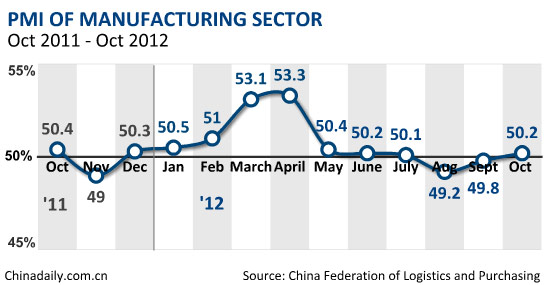
BEIJING - China's manufacturing activity rejuvenated in October, official data showed Thursday.
The purchasing managers' index rose to 50.2 percent in October from 49.8 percent in September, just above the 50-percent figure that demarcates expansion from contraction, according to data released by the China Federation of Logistics and Purchasing.
Swinging above the boom-bust line, the October index indicated that the economy's downward movement may be reversing, according to experts.

"The regain shows the economy is improving, and I believe there will be a modest rise in the fourth quarter," said Cai Jin, CFLP vice-chairman.
Readings for sub-indices have also indicated expansion. The sub-index for new orders climbed 0.6 percentage points from September to 50.4 percent last month. The output sub-index for October stood at 52.1 percent, up 0.8 percentage points from the previous month.
Readings for sub-indices have also indicated expansion. The sub-index for new orders climbed 0.6 percentage points from September to 50.4 percent last month. The output sub-index for October stood at 52.1 percent, up 0.8 percentage points from the previous month.
The sub-index for new export orders rose 0.5 percentage points from September to 49.3 percent, while the import sub-index climbed 0.7 percentage points to 48.4 percent.
"Improvements in the overall factory activity and some PMI sub-indices means companies have generally finished destocking, which will lay a good foundation for fourth-quarter growth," said Zhang Liqun, an analyst with the Development Research Center of the State Council, a government think tank.
The PMI rebounded to 49.8 percent in September, ending four straight months of decline. The index fell below the boom-bust line in August for the first time since November 2011.
Also on Thursday, the final reading of a privately-compiled survey by HSBC was released. It put the October PMI for Chinese manufacturers at an eight-month-high of 49.5 percent, up from 47.9 percent in September.
HSBC economist Qu Hongbin said the increase indicated that the country's pro-growth measures are starting to take effect. He said policy makers will continue to take an easy policy stance to boost domestic consumption and the economy will see a modest recovery in coming quarters.
Data released last month by the National Bureau of Statistics showed that China's economic growth slowed to an annual rate of 7.4 percent in the third quarter. However, September data indicated a pick-up in economic activity.
To buoy the slowing economy, the Chinese government has rolled out an array of measures this year, including two cuts to benchmark interest rates, the easing of bank reserve requirements and the approval of infrastructure projects worth more than one trillion yuan ($157.73 billion).
Liu Ligang, an economist with the ANZ National Bank Ltd, said local investment programs have fueled overall economic growth and the trend will continue after the once-a-decade leadership change.
A new Communist Party of China leadership will emerge during the CPC's 18th National Congress on Nov 8.
Liu said China's demand for commodities may increase in the foreseeable future and the central bank is less likely to lower banks' reserve requirement ratios or conduct massive reverse repos in recent months.
The central bank on Tuesday injected a record high of 395 billion yuan into the financial system via reverse repos in order to ease a cash squeeze at the end of October.
The central bank prefers reverse repos over reserve requirement ratio cuts when easing money supplies to prevent a rebound in housing and commodity prices.
Boosted by news of an increase of manufacturing activities, Chinese stocks closed higher on Thursday with the benchmark Shanghai Composite Index up 1.73 percent, or 35.84 points, to 2,104.72.
The Shenzhen Component Index closed at 8,663.15, up 193.35 points, or 2.28 percent.